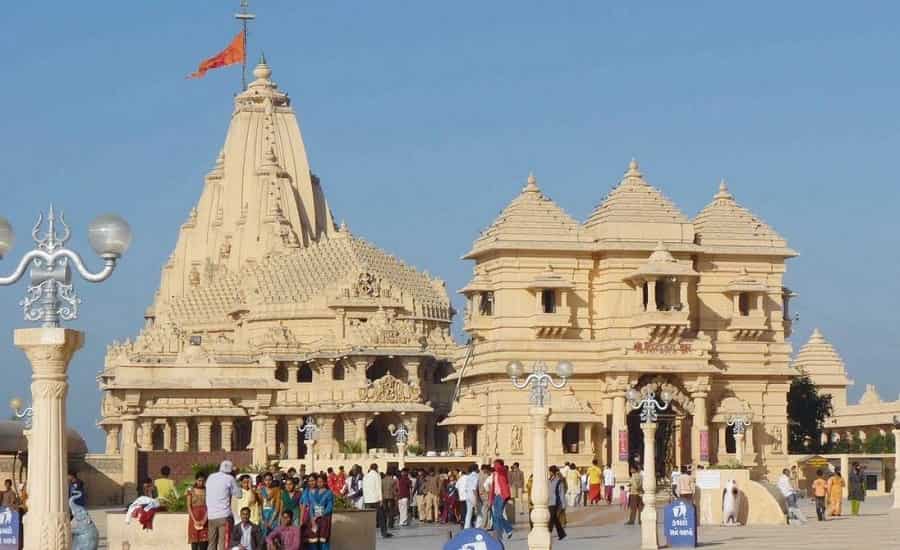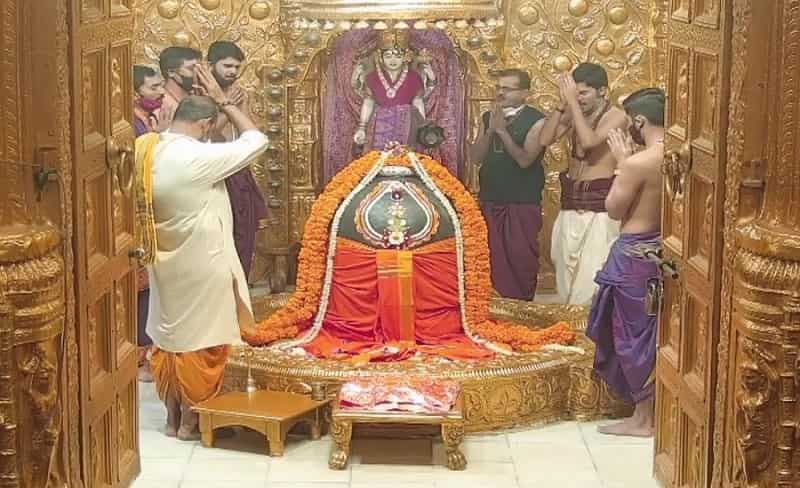Somnath Temple, located in Gujarat, India, is one of the most revered and ancient temples dedicated to Lord Shiva. With a history dating back thousands of years, the temple holds immense religious and historical significance. Visitors from around the world come to witness the grandeur of this spiritual landmark and participate in its various rituals, including darshan, aarti, and the mesmerizing light and sound show.
The Somnath Temple, also known as the Shrine Eternal, is situated on the western coast of Gujarat, overlooking the Arabian Sea. It is believed to be the first among the twelve Jyotirlinga shrines of Lord Shiva and holds a special place in Hindu mythology. The temple has witnessed destruction and reconstruction multiple times throughout history, symbolizing the triumph of faith and devotion.

Historical Significance of Somnath Temple
The history of Somnath Temple is shrouded in legends and tales of valor. It is said that the original temple was built by Lord Soma, the Moon God, out of gold, and was later rebuilt by Lord Krishna himself. Over the centuries, the temple faced numerous invasions and was destroyed by foreign forces. However, it was always resurrected to stand as a symbol of spiritual resilience and unwavering devotion.
Architecture and Design of Somnath Temple
The architecture of Somnath Temple is a marvelous blend of Chalukya and Solanki styles. The temple complex showcases intricate carvings, magnificent domes, and spires that reach towards the heavens. The sanctum sanctorum houses the lingam, a representation of Lord Shiva, and is surrounded by awe-inspiring sculptures and sculptures depicting various episodes from Hindu mythology.
Importance of Darshan at Somnath Temple
Darshan, which means “divine sight” or “glimpse,” holds immense significance for devotees visiting Somnath Temple. It is an opportunity to have a personal encounter with the divine and seek blessings from Lord Shiva. The darshan timings are strictly followed to ensure a smooth and organized flow of devotees.
Darshan Timings and Guidelines
The darshan timings at Somnath Temple vary based on the time of year and the prevailing rituals. Generally, the temple opens early in the morning and remains accessible to devotees until late evening. It is important to check the specific darshan timings before planning your visit to ensure you don’t miss the opportunity to seek blessings.
To maintain order and facilitate a smooth darshan experience, the temple authorities have implemented certain guidelines. It is advisable to follow these guidelines to show respect and reverence towards the sacred place. Some common guidelines include:
- Dress modestly: Wear attire that covers your shoulders and knees as a sign of respect for the religious ambiance.
- Remove footwear: Devotees are required to remove their footwear before entering the temple premises.
- Maintain silence: Maintain a peaceful and serene atmosphere by refraining from unnecessary chatter and maintaining a respectful silence.
- No photography: Photography is generally not allowed inside the temple premises to maintain the sanctity of the place and avoid distractions for fellow devotees.
Rituals and Customs during Darshan
During the darshan, devotees have the opportunity to offer their prayers and seek blessings from Lord Shiva. The customary practice involves standing in queues and patiently waiting for your turn to enter the sanctum sanctorum. As you approach the lingam, you can offer flowers, garlands, and other offerings as a gesture of devotion.
Devotees often recite prayers and mantras while in the presence of the lingam. It is believed that this intimate connection with the divine brings solace, blessings, and fulfillment of desires. The atmosphere is filled with a sense of spirituality, devotion, and a shared sense of faith among the devotees.
Aarti at Somnath Temple

Aarti is a significant ritual performed in Hindu temples to honor and express devotion to the deity. At Somnath Temple, the aarti ceremony is a mesmerizing experience that adds a touch of grandeur to the spiritual ambiance. It is a visual and auditory spectacle that captivates the hearts of devotees.
Aarti Timings and Significance
The aarti at Somnath Temple takes place twice a day, in the morning and evening. The morning aarti, known as the “Mangala Aarti,” is performed at sunrise, while the evening aarti, called the “Sandhya Aarti,” takes place after sunset. The rhythmic chants, melodious hymns, and the mesmerizing sight of the aarti lamps being waved in front of the deity create a captivating atmosphere filled with divine energy.
The aarti is a form of devotional offering where lamps, usually adorned with ghee or oil, are lit and circled in a clockwise motion in front of the deity. This ritual is accompanied by the chanting of sacred mantras and bhajans (devotional songs), creating an enchanting environment of devotion and spirituality.
Darshan Timings:
- Morning Darshan: 6:00 AM to 12:00 PM
- Afternoon Darshan: 4:00 PM to 9:00 PM
Aarti Timings:
- Morning Aarti: 7:00 AM to 7:30 AM
- Evening Aarti: 7:00 PM to 7:30 PM
Please note that these timings are subject to change, especially during festivals and special events. It is advisable to check with the temple authorities or visit the official website for the most up-to-date information before planning your visit.
Experience of Aarti at Somnath Temple
Participating in the aarti at Somnath Temple is a soul-stirring experience that leaves a lasting impression. As the aarti lamps illuminate the surroundings, the air becomes charged with positive energy and devotion. The melodious hymns sung during the aarti resonate deep within the hearts of the devotees, creating a sense of unity and devotion.
The rhythmic movements of the aarti lamps, the fragrance of incense, and the collective prayers offered by devotees create a surreal experience. It is a moment of deep connection with the divine, where one’s worries and worldly burdens seem to fade away in the presence of the divine light.
Light and Sound Show at Somnath Temple
Another captivating experience at Somnath Temple is the mesmerizing light and sound show that takes place in the evening. This unique spectacle showcases the rich history and cultural significance of the temple through a combination of lights, sound effects, and narration.
Light and Sound Show Timings:
- Show Language: Hindi (English on request)
- Show Duration: Approximately 25 minutes
Show Timings:
- November to February: 7:00 PM (First Show) and 8:00 PM (Second Show)
- March to October: 7:30 PM (First Show) and 8:30 PM (Second Show)
Timings and Schedule of Light and Sound Show
The light and sound show at Somnath Temple is held after sunset, providing a magical ambiance to the temple complex. The show typically lasts for about 30 minutes and takes place in multiple languages, including English, Hindi, and Gujarati. The exact timings of the show may vary depending on the time of year, so it is advisable to check the schedule beforehand.
The show takes spectators on a journey through time, recounting the legends, historical events, and the spiritual heritage associated with Somnath Temple. The synchronized play of lights on the temple’s magnificent architecture, combined with the evocative sound effects and narrative, creates a captivating audio-visual experience that leaves a lasting impression.
Highlights and Features of the Show
The light and sound show at Somnath Temple is a spectacle that highlights the rich heritage and significance of the temple. Here are some key features of the show:
Illumination: The temple’s architecture is beautifully illuminated, accentuating its intricate carvings, domes, and spires. The play of lights enhances the grandeur of the temple, creating a mesmerizing visual spectacle.
Narration: The show is accompanied by a captivating narration that takes the audience on a historical and spiritual journey. The narrative weaves together the legends, mythological stories, and historical events associated with Somnath Temple, providing a deeper understanding of its significance.
Sound Effects: The use of sound effects adds depth and emotion to the storytelling. From the resonating chants to the sounds of ancient battles, the audio elements create an immersive experience, transporting the audience back in time.
Visual Effects: The show incorporates visual effects that enhance the storytelling experience. These effects include projections, animations, and multimedia presentations that further bring the history and mythology associated with Somnath Temple to life.
The combination of lights, sound, and visuals in the light and sound show at Somnath Temple creates a truly enchanting experience, leaving visitors awestruck and spiritually enriched.
Tips for Visiting Somnath Temple
If you are planning to visit Somnath Temple, here are some useful tips to ensure a smooth and memorable experience:
Dress Code and Etiquette
When visiting Somnath Temple, it is important to dress modestly and adhere to the temple’s dress code. Men are advised to wear traditional attire like dhoti-kurta or trousers with a shirt, while women can opt for sarees or salwar-kameez. Avoid wearing revealing or inappropriate clothing out of respect for the temple’s sanctity.
Additionally, it is crucial to maintain decorum and follow the prescribed etiquette while inside the temple. Keep noise to a minimum, refrain from touching or leaning on the temple’s structures, and be mindful of the sacred atmosphere.
Best Time to Visit
Somnath Temple can be visited throughout the year, but it is advisable to plan your visit during the cooler months, between October and February, to avoid extreme temperatures. The temple experiences a high influx of devotees during festivals and auspicious occasions, so it’s recommended to check the festival calendar and plan accordingly if you wish to witness special rituals and ceremonies.
Nearby Attractions and Accommodation
While visiting Somnath Temple, take the opportunity to explore the nearby attractions. The serene Somnath Beach, located in close proximity, offers a peaceful retreat where you can relax and enjoy the tranquil shores of the Arabian Sea. The Junagadh Gate, Bhalka Tirth, and Triveni Sangam are also worth visiting for their historical and spiritual significance.
When it comes to accommodation, there are several options available near Somnath Temple to suit different budgets and preferences. From luxury hotels to budget guesthouses, you can find a range of accommodations in the vicinity. It is advisable to book your accommodation in advance, especially during peak tourist seasons, to ensure a comfortable stay.
Conclusion
Visiting Somnath Temple for darshan, experiencing the enchanting aarti, and witnessing the captivating light and sound show is a journey that intertwines spirituality, history, and cultural heritage. The temple’s rich history, architectural splendor, and religious significance make it a must-visit destination for devotees and history enthusiasts alike. By following the darshan guidelines, participating in the aarti, and immersing yourself in the light and sound show, you can create a truly transformative and memorable experience.
FAQs (Frequently Asked Questions)
Q-1: Can I take photographs during Darshan?
Photography is generally not allowed inside the temple premises to maintain the sanctity of the place and avoid distractions for fellow devotees.
Q-2: Are there any entry fees for the Light and Sound Show?
Yes, there is a nominal entry fee for attending the light and sound show at Somnath Temple. The exact fee may vary, so it’s recommended to check the current rates before your visit.
Q-3: How long does the Aarti ceremony last?
The Aarti ceremony at Somnath Temple lasts for about 15 to 20 minutes. It is a brief but captivating experience that leaves a lasting impression.
Q-4: Is there any specific dress code for visiting the temple?
Yes, there is a dress code for visiting Somnath Temple. Men are advised to wear traditional attire like dhoti-kurta or trousers with a shirt, while women can opt for sarees or salwar-kameez. Dressing modestly is important to show respect for the religious ambiance.
Q-5: Are there any restrictions for offering prayers at Somnath Temple?
While there are no specific restrictions for offering prayers at Somnath Temple, it is important to follow the guidelines provided by the temple authorities. Maintaining silence, showing respect for the sanctity of the place, and adhering to the customs and rituals will ensure a peaceful and meaningful experience.

